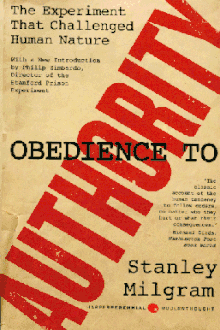Obedience to Authority: An Experimental View
Obedience to Authority: An Experimental View is a 1974 book by social psychologist Stanley Milgram concerning a series of experiments on obedience to authority figures he conducted in the early 1960s. This book provides an in-depth look into his methods, theories and conclusions.
 2009 Cover | |
| Author | Stanley Milgram |
|---|---|
| Country | United States |
| Language | English |
| Subject | Psychology, Social Psychology, Sociology - Social Theory, Authority, Obedience |
| Publisher | Harper & Row |
Publication date | 1974 |
| Media type | Print (Hardback and Paperback) |
| Pages | 219 |
| ISBN | 0-422-74580-4 |
Background
Between 1961 and 1965, Milgram carried out a series of experiments at Yale University in which human subjects were instructed to administer what they thought were progressively more painful electric shocks to another human being to determine to what extent people would obey orders even when they knew them to be painful and immoral. The experiments came under heavy criticism at the time but were ultimately vindicated by the scientific community.
Milgram's experiments on obedience to authority are considered among the most important psychological studies of this century. Perhaps because of the enduring significance of the findings—the surprising ease with which ordinary persons can be commanded to act destructively against an innocent individual by a legitimate authority—it continues to claim the attention of psychologists and other social scientists, as well as the general public.
In 1963, Milgram published The Behavioral Study of Obedience[1] in the Journal of Abnormal and Social Psychology, which included a detailed experiment record and experiment of the controversial electric shock experiment. There were two stunning findings. The first was the extraordinary strength of the obedience and the second was the tension such experiment brought to participants.[1] Nevertheless, all participants reached an electric shock of 300 or more.
Contents
- The Dilemma of Obedience
- Methodology of Inquiry
- Expected Behavior
- Closeness of the Victim
- Individuals Confront Authority
- Further Variations and Control
- Individuals Confront Authority II
- Role Permutations
- Group Effects
- Why Obedience?—An Analysis
- The Process of Obedience: Applying the Analysis to the Experiment
- Strain and Disobedience
- An Alternative Theory: Is Aggression the Key?
- Problems of Method
- Epilogue
- Appendix I: Problems of Ethics in Research
- Appendix II: Patterns Among Individuals
Editions
- Milgram, S. (1974), Obedience to Authority: An Experimental View, London: Tavistock Publications.
- Milgram, S. (2005), Obedience to Authority: An Experimental View, Pinter & Martin Ltd.; New edition, paperback: 240 pages ISBN 0-9530964-7-5 ISBN 978-0953096473
- Milgram, S. (2009), Obedience to Authority: An Experimental View, Harper Perennial Modern Classics; Reprint edition, paperback: 256 pages ISBN 0-06-176521-X ISBN 978-0061765216
References
- Milgram, Stanley (1963). "Behavioral Study of Obedience" (PDF). Journal of Abnormal and Social Psychology. 67 (4): 371–378. CiteSeerX 10.1.1.599.92. doi:10.1037/h0040525. PMID 14049516 – via lphslibrary.